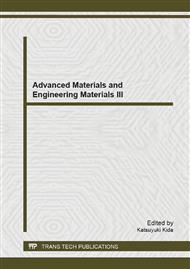[1]
M. Akgül, A. Karabakan, O. Acar, Y. Yürüm, Removal of silver (I) from aqueous solutions with clinoptilolite, Microporous Mesoporous Mater. 94 (2006) 99–104.
DOI: 10.1016/j.micromeso.2006.02.023
Google Scholar
[2]
S. Zafar, N. Khalid, and M.L. Mirza, Potential of Rice Husk for the Decontamination of Silver Ions from Aqueous Media, Sep. Sci. Technol. 47(2012) 1793-1801.
DOI: 10.1080/01496395.2012.657322
Google Scholar
[3]
K. Vijayaraghavan, and Y.S. Yun, Bacterial biosorbents and biosorption, Biotechnol. Adv., 26(2008) 266–291.
Google Scholar
[4]
E. Guibal, Interactions of metal ions with chitosan-based sorbents: a review, Sep. Purif. Technol. 38(2004) 43–74.
Google Scholar
[5]
P. Baroni, R.S. Vieira, E. Meneghetti, M.G. Silva, and M.M. Beppu, Evaluation of batch adsorption of chromium ions on natural and crosslinked chitosan membranes, J. Hazard. Mater. 152 (2008) 1155–1163.
DOI: 10.1016/j.jhazmat.2007.07.099
Google Scholar
[6]
S.F. Wang, L. Shen, W.D. Zhang, and Y.J. Tong, Preparation and mechanical properties of chitosan/carbon nanotubes composites, Biomacromolecule. 6(2005) 3067-3072.
DOI: 10.1021/bm050378v
Google Scholar
[7]
C. Hao, L. Ding, X. Zhang, and H. Ju, Biocompatible conductive architecture of carbon nanofiber-doped chitosan prepared with controllable electrodeposition for cytosensing, Anal. Chem. 79(2007) 4442-4447.
DOI: 10.1021/ac062344z
Google Scholar
[8]
R. G. Long, and R.T. Yang, Carbon nanotubes as superior sorbent for Dioxin removal, J. Am. Chem. Soc. 123(2001) 2058-(2059).
DOI: 10.1021/ja003830l
Google Scholar
[9]
Y.H. Li, S. Wang, J. Wei, X. Zhang, C. Xu, Z. Luan, D. Wu, and B. Wei, Lead adsorption on carbon nanotubes, Chem. Phys. Lett. 357(2002) 263-266.
DOI: 10.1016/s0009-2614(02)00502-x
Google Scholar
[10]
C. L Lasko, and M.P. Hurst, An investigation into the use of chitosan for the removal of soluble silver from industrial wastewater, Environ. Sci. Technol 33(1999) 3622-3626.
DOI: 10.1021/es980443r
Google Scholar
[11]
Y.H. Li, S. Wang, J. Wei, X. Zhang, C. Xu, Z. Luan, D. Wu, and B. Wei, Lead adsorption on carbon nanotubes, Chem. Phys. Lett. 357(2002) 263-266.
DOI: 10.1016/s0009-2614(02)00502-x
Google Scholar
[12]
A. Sari, M. Tüzen. Adsorption of silver from aqueous onto raw vermiculite and manganese oxide-modified vermiculite, Microporous Mesoporous Mater. 170 (2013) 155-163.
DOI: 10.1016/j.micromeso.2012.12.004
Google Scholar
[13]
M. Ahmaruzzaman, and S.G. Laxmi, Batch adsorption of 4-nitrophenol by acid activated jute stick char: Equilibrium, kinetic and thermodynamic studies, Chem. Eng. J. 158 (2010) 173–180.
DOI: 10.1016/j.cej.2009.12.027
Google Scholar


